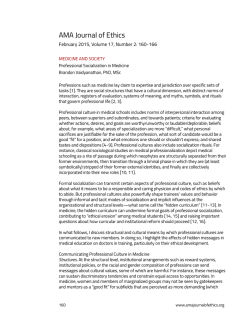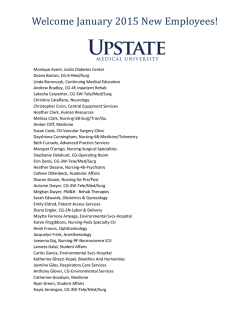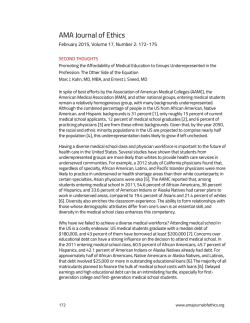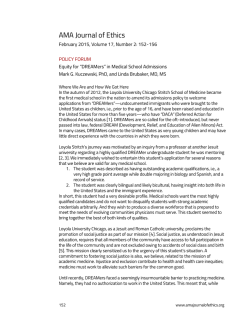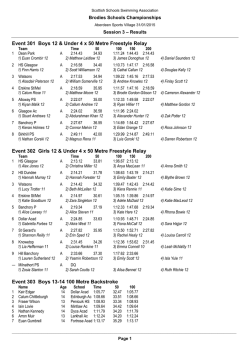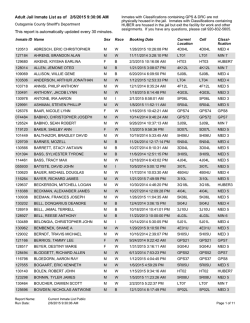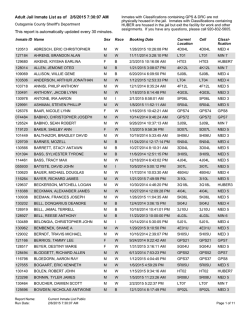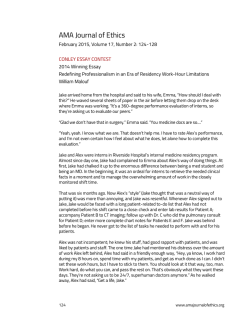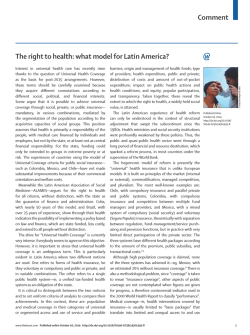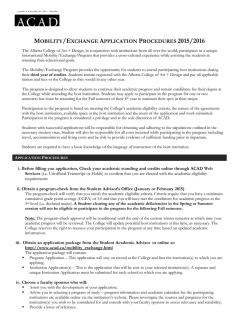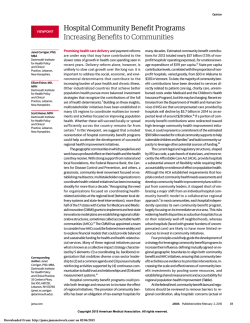
PDF - AMA Journal of Ethics - American Medical Association
AMA Journal of Ethics February 2015, Volume 17, Number 2: 176-186 Suggested Readings and Resources Abbott A. The System of Professions: An Essay on the Division of Expert Labor. Chicago, IL: University of Chicago Press; 1988. Accreditation Council for Graduate Medical Education. Internal medicine subspecialty reporting milestones: frequently asked questions. http://www.acgme.org/acgmeweb/Portals/0/PDFs/Milestones/InternalMedicineSubspeci altyMilestonesFAQs.pdf. Revised March 6, 2014. Accessed December 18, 2014. ACGME Task Force on Quality Care and Professionalism. The ACGME 2011 Duty Hour Standards: Enhancing Quality of Care, Supervision, and Resident Professional Development. Chicago, IL: Accreditation Council for Graduate Medical Education; 2011. http://www.acgme.org/acgmeweb/Portals/0/PDFs/jgme-monograph%5B1%5D.pdf. Accessed December 17, 2014. Alexander SC, Keitz SA, Sloane R, Tulsky JA. A controlled trial of a short course to improve residents’ communication with patients at the end of life. Acad Med. 2006;81(11):10081012. American Medical Student Association (AMSA). Enriching medicine through diversity. http://www.amsa.org/AMSA/Homepage/About/Priorities/Diversity.aspx. Accessed December 19, 2014. Association of American Medical Colleges. Diversity in Medical Education: Facts and Figures 2012. Washington, DC: Association of American Medical Colleges; 2012. https://members.aamc.org/eweb/upload/Diversity%20in%20Medical%20Education_Facts %20and%20Figures%202012.pdf. Accessed December 19, 2014. Association of American Medical Colleges. Financial aid fact sheets. https://www.aamc.org/services/first/first_factsheets. Accessed December 15, 2014. Association of American Medical Colleges. FIRST for medical education. https://www.aamc.org/services/first/. Accessed December 19, 2014. Association of American Medical Colleges. Medical school policies on deferred action for childhood arrivals. https://www.aamc.org/students/download/404292/data/daca.pdf. Accessed November 1, 2014. Association of American Medical Colleges. Medical student education: debt, costs, and loan repayment fact card. October 2014. https://www.aamc.org/download/152968/data/debtfactcard.pdf. Accessed December 19, 2014. 176 www.amajournalofethics.org Association of American Medical Colleges. Taking control of credit card debt. https://www.aamc.org/services/first/first_factsheets/111916/taking_control_of_credit _card_debt.html. Accessed December 15, 2014. Association of American Medical Colleges. US medical school applicants, 2007-2014: race/ethnicity self-identification counts with an applicant able to appear in more than one race/ethnicity category. October 21, 2014. https://www.aamc.org/download/411642/data/10282014.pdf. Accessed December 19, 2014. Bakker AB, Schaufeli WB, Sixma HJ, Bosveld W, Van Dierendonck D. Patient demands, lack of reciprocity, and burnout: a five-year longitudinal study among general practitioners. J Organ Behav. 2000;21(4):425-441. Balderas-Medina Anaya Y, Del Rosario M, Doyle LH, Hayes-Bautista DE. Undocumented students pursuing medical education: the implications of deferred action for childhood arrivals (DACA). Acad Med. 2014;89(12):1599-1602. Barger LK, Ayas NT, Cade BE, et al. Impact of extended-duration shifts on medical errors, adverse events, and attentional failures. PLoS Med. 2006;3(12):e487. Becker HS, Geer B, Hughes EC, Strauss AL. Boys in White: Student Culture in Medical School. Chicago, IL: University of Chicago Press; 1961. Benbassat J. Undesirable features of the medical learning environment: a narrative review of the literature. Adv Health Sci Educ Theory Pract. 2013;18(3):527. Bombeke K, Symons L, Mortelmans D, et al. “More shades of grey in my answers”: an interview study revisiting attitude erosion during clerkships. Med Educ. 2013;47(5):476484. Bourdieu P. Homo Academicus. Collier P, trans. Stanford, CA: Stanford University Press; 1988. Bourdieu P, Nice R. Outline of a Theory of Practice. Cambridge, UK: Cambridge University Press; 1977. Brainard AH, Brislen HC. Viewpoint: learning professionalism: a view from the trenches. Acad Med. 2007;82(11):1010-1014. Branch W, Pels RJ, Lawrence RS, Arky R. Becoming a doctor. Critical-incident reports from third-year medical students. N Engl J Med. 1993;329(15):1130-1132. Brown Alpert Medical School. Doctoring: the prescription for curriculum innovation. https://brown.edu/academics/medical/sites/brown.edu.academics.medical/files/uploads/ Doctoring_Brochure.pdf. Accessed December 30, 2014. AMA Journal of Ethics, February 2015 177 Browning DM, Meyer EC, Truog RD, Solomon MZ. Difficult conversations in health care: cultivating relational learning to address the hidden curriculum. Acad Med. 2007;82(9):905913. Cech E, Rubineau B, Silbey S, Seron C. Professional role confidence and gendered persistence in engineering. Am Soc Rev. 2011;76(5):641-666. Cech EA. Ideological wage inequalities? The technical/social dualism and the gender wage gap in engineering. Soc Forces. 2013;91(4):1147-1182. Cech EA. The self-expressive edge of occupational sex segregation. Am J Sociol. 2013;119(3):747-789. Chen JL, Sosnov J, Lessard D, Goldberg RJ. Impact of do-not-resuscitate orders on quality of care performance measures in patients hospitalized with acute heart failure. Am Heart J. 2008;156(1):78-84. Chiu S. On doctoring. http://medstudentstories.merckmanuals.com/on-doctoring/. Merck Manuals Student Stories. Accessed December 30, 2014. Christakis DA, Feudtner C. Ethics in a short white coat: the ethical dilemmas that medical students confront. Acad Med. 1993;68(4):249-254. Cohen RI, Lisker GN, Eichorn A, Multz AS, Silver A. The impact of do-not-resuscitate order on triage decisions to a medical intensive care unit. J Crit Care. 2009;24(2):311-315. Cohn S, Fritz ZBM, Frankau JM, Laroche CM, Fuld JP. Do not attempt cardiopulmonary resuscitation orders in acute medical settings: a qualitative study. Q J Med. 2013;106:165. Colliver JA, Conlee MJ, Verhulst SJ, Dorsey JK. Reports of the decline of empathy during medical education are greatly exaggerated: a reexamination of the research. Acad Med. 2010;85(4):588-593. Confirmation of Antitrust Status of Graduate Medical Resident Matching Programs, 15 USC section 37b(A)-(E) (2004). Croasdale M. New legislation protects the match from antitrust litigation. Am Med News. May 3, 2004. http://www.amednews.com/article/20040503/profession/305039954/7/. Accessed December 17, 2014. Crump C, Ned J, Winkleby MA. The Stanford Medical Youth Science Program: educational and science-related outcomes [published ahead of print August 6, 2014]. Adv Health Sci Educ Theory Pract. doi:10.1007/s10459-014-9540-6. 178 www.amajournalofethics.org Dartmouth University Geisel School of Medicine. MDED 116: On Doctoring - year 1. https://geiselmed.dartmouth.edu/ed_programs/courses/courses_yr1_newd116.shtml. Accessed December 30, 2014. DeLisa JA, Thomas P. Physicians with disabilities and the physician workforce: a need to reassess our policies. Am J Phys Med Rehabil. 2005;84(1):5-11. DiLalla LF, Hull SK, Dorsey JK; Department of Family and Community Medicine, Southern Illinois University School of Medicine. Effect of gender, age, and relevant course work on attitudes toward empathy, patient spirituality, and physician wellness. Teach Learn Med. 2004;16(2):165-170. Drazen JM, Epstein AM. Rethinking medical training: the critical work ahead. N Engl J Med. 2002;347(16):1271-1272. Fallowfield L, Jenkins V, Farewell V, Saul J, Duffy A, Eves R. Efficacy of a Cancer Research UK communication skills training model for oncologists: a randomised controlled trial. Lancet. 2002;359(9307):650-656. Feudtner C, Christakis DA. Making the rounds. The ethical development of medical students in the context of clinical rotations. Hastings Cent Rep. 1994;24(1):6-12. Fox RC. Training for uncertainty. In: Merton RK, Reader GG, Kendall PL, eds. The StudentPhysician: Introductory Studies in the Sociology of Medical Education. Cambridge, MA: Harvard University Press; 1957:207-241. Fritz Z, Fuld J, Haydock S, Palmer C. Interpretation and intent: a study of the (mis)understanding of DNAR orders in a teaching hospital. Resuscitation. 2010;81(9):11381141. Garcia M. Students not legal—but superb. Chicago Sun-Times. October 30, 2014. http://www.suntimes.com/news/garcia/30742282-452/students-not-legal-butsuperb.html. Accessed November 1, 2014. Gaufberg EH, Batalden M, Sands R, Bell SK. The hidden curriculum: what can we learn from third-year medical student narrative reflections? Acad Med. 2010;85(11):1709-1716. Girard R. “To Double Business Bound”: Essays on Literature, Mimesis, and Anthropology. Baltimore, MD: Johns Hopkins University Press; 1988. Goitein L, Ludmerer KM. Resident workload: let’s treat the disease, not just the symptom. JAMA Intern Med. 2013;173(8):655-656. Goldie J. The formation of professional identity in medical students: considerations for educators. Med Teach. 2012;34(9):e641-e648. AMA Journal of Ethics, February 2015 179 Goldman B. The Secret Language of Doctors: Cracking the Code of Hospital Slang. Toronto, Canada: HarperCollins; 2014. Green MJ. What (if anything) is wrong with residency overwork? Ann Intern Med. 1995;123(7):512-517. Greenberg R. AAMC extends fee assistance program to students with DACA status; admissions policies open doors. AAMC Reporter. October 2014. https://www.aamc.org/newsroom/reporter/412110/fee-assistance.html. Accessed November 1, 2014. Grusky D. Foundations of a neo-Durkheimian class analysis. In: Wright EO, ed. Approaches to Class Analysis. Cambridge, UK: Cambridge University Press; 2005:51-81. Haas J, Shaffir W. Ritual evaluation of competence: the hidden curriculum of professionalization in an innovative medical school program. Work Occup. 1982;9(2):131154. Haas J, Shaffir W. The ‘‘fate of idealism’’ revisited. J Contemp Ethnography. 1984;13(1):6381. Haas J, Shaffir W. The professionalization of medical students: developing competence and a cloak of competence. Symb Interact. 1977;1(1):71-88. Hafferty FW, Franks R. The hidden curriculum, ethics teaching, and the structure of medical education. Acad Med. 1994;69(11):861-871. Hafferty FW, O’Donnell JF, eds. The Hidden Curriculum in Health Professions Education. Lebanon, NH: Dartmouth College Press; 2014. Hafferty FW. Beyond curriculum reform: confronting medicine’s hidden curriculum. Acad Med. 1998;73(4):403-407. Hafferty FW. Professionalism and the socialization of medical students. In: Cruess RL, Cruess SR, Steinert Y, eds. Teaching Medical Professionalism. Cambridge, UK: Cambridge University Press; 2008:53-72. Haidet P, Stein HF. The role of the student-teacher relationship in the formation of physicians: the hidden curriculum as process. J Gen Intern Med. 2006;21(suppl 1):S16-S20. Halbesleben JR, Wakefield DS, Wakefield BJ. Work-arounds in health care settings: literature review and research agenda. Health Care Manage Rev. 2008;33(1):2-12. Hall P. Interprofessional teamwork: professional cultures as barriers. J Interprof Care. 2005;19(suppl 1):188-196. Hartman DW, Hartman CW. Disabled students and medical school admissions. Arch Phys Med Rehabil. 1981;62(2):90-91. 180 www.amajournalofethics.org Hartocollis A. Getting into med school without hard sciences. New York Times. July 29, 2010. http://www.nytimes.com/2010/07/30/nyregion/30medschools.html?pagewanted=all&_r =0. Accessed December 19, 2014. Hodges BD. A tea-steeping or I-Doc model for medical education? Acad Med. 2010;85(9 Suppl):S34-S44. Hojat M, Louis DZ, Markham FW, Wender R, Rabinowitz C, Gonnella JS. Physicians’ empathy and clinical outcomes for diabetic patients. Acad Med. 2011;86(3):359-364. Hojat M, Mangione S, Nasca TJ, et al. An empirical study of decline in empathy in medical school. Med Educ. 2004;38(9):934-941. Hojat M, Mangione S, Nasca TJ, Gonnella JS, Magee M. Empathy scores in medical school and ratings of empathic behavior in residency training 3 years later. J Soc Psychol. 2005;145(6):663-672. Hojat M, Vergare MJ, Maxwell K, et al. The devil is in the third year: a longitudinal study of erosion of empathy in medical school. Acad Med. 2009;84(9):1182-1191. Hupert N, Pels RJ, Branch WT Jr. Learning the art of doctoring: use of critical incident reports. Harvard Student BMJ. 1995;3:99-100. Institute of Medicine Committee on Approaching Death. Dying in America: Improving Quality and Honoring Individual Preferences Near the End of Life. Washington, DC: National Academies Press; 2014. http://books.nap.edu/openbook.php?record_id=18748. Accessed December 18, 2014. Issenberg SB, McGaghie WC, Hart IR, et al. Simulation technology for health care professional skills training and assessment. JAMA. 1999;282(9):861-866. Jenkins V, Fallowfield L. Can communication skills training alter physicians’ beliefs and behavior in clinics? J Clin Oncol. 2002;20(3):765-769. Jolly P. Diversity of US medical students by parental income. AAMC Analysis in Brief. 2008;8(1):1-2. https://www.aamc.org/download/102338/data/aibvol8no1.pdf. Accessed December 19, 2014. Jung v Association of American Medical Colleges, 339 F Supp 2d 26, 31 (DDC 2004). Kahn MJ, Nelling EF. Estimating the value of medical education: a net present value approach. Teach Learn Med. 2010;22(3):205-208. Karnieli-Miller O, Vu TR, Frankel RM, et al. Which experiences in the hidden curriculum teach students about professionalism? Acad Med. 2011;86(3):369-377. AMA Journal of Ethics, February 2015 181 Kay J. Traumatic deidealization and the future of medicine. JAMA. 1990;263(4):572-573. Kopelman L. Cynicism among medical students. JAMA. 1983;250(15):2006-2010. Kuczewski MG, Brubaker L. Accepting undocumented immigrants: how we became the “medical school of dreams” and Dreamers. AM Rounds: Beyond the Pages of Academic Medicine. July 3, 2014. http://academicmedicineblog.org/accepting-undocumentedimmigrants-how-we-became-the-medical-school-of-dreams-and-dreamers/. Accessed November 1, 2014. Kuczewski MG, Brubaker L. Medical education for “Dreamers”: barriers and opportunities for undocumented immigrants. Acad Med. 2014;89(12):1593-1598. Landrigan CP, Rothschild JM, Cronin JW, et al. Effect of reducing interns’ work hours on serious medical errors in intensive care units. N Engl J Med. 2004;351(18):1838-1848. Langewitz WA, Eich P, Kiss A, Wössmer B. Improving communication skills—a randomized controlled behaviorally oriented intervention study for residents in internal medicine. Psychosom Med. 1998;60(3):268-276. Lee DY, Myers EA, Rehmani SS, et al. Surgical residents’ perception of the 16-hour work day restriction: concern for negative impact on resident education and patient care. J Am Coll Surg. 2012;215(6):868-877. Lempp H, Seale C. The hidden curriculum in undergraduate medical education: qualitative study of medical students’ perceptions of teaching. BMJ. 2004;329(7469):770-773. Lewis SB. The physically handicapped physician. In: Callan JP, ed. The Physician: A Professional under Stress. Norwalk, CT: Appleton-Century-Crofts; 1983:318-326. Long K. UW medical school to allow nonlegal residents. Seattle Times. September 30, 2014. http://seattletimes.com/html/localnews/2024665852_dacamedschoolxml.html. Accessed November 1, 2014. Lopez L, Katz JT. Perspective: creating an ethical workplace: reverberations of resident work hours reform. Acad Med. 2009;84(3):315-319. Lowenstein J. Where have all the giants gone? Reconciling medical education and the traditions of patient care with limitations on resident work hours. Perspect Biol Med. 2003;46(2):273-282. Loyola University Chicago. Mission and identity. http://www.luc.edu/mission/mission_vision.shtml. Accessed December 14, 2014. Loyola University Chicago Stritch School of Medicine. Admission. http://www.stritch.luc.edu/admission. Accessed December 19, 2014. 182 www.amajournalofethics.org Loyola University Chicago Stritch School of Medicine. DREAMers of DACA status welcome. http://www.stritch.luc.edu/daca. Accessed December 18, 2014. Ludmerer KM. Redesigning residency education: moving beyond work hours. N Engl J Med. 2010;362(14):1337-1338. Maguire P, Pitceathly C. Key communication skills and how to acquire them. BMJ. 2002;325(7366):697-700. McGee R, Saran S, Krulwich TA. Diversity in the biomedical research workforce: developing talent. Mt Sinai J Med. 2012;79(3):397-411. Miller FH, Greaney TL. The National Resident Matching Program and antitrust law. JAMA. 2003;289(7):913-918. Mizrahi T. Getting Rid of Patients: Contradictions in the Socialization of Physicians. New Brunswick, NJ: Rutgers University Press; 1986. Newton BW, Barber L, Clardy J, Cleveland E, O’Sullivan P. Is there hardening of the heart during medical school? Acad Med. 2008;83(3):244-249. Ogle J, Bushnell JA, Caputi P. Empathy is related to clinical competence in medical care. Med Educ. 2013;47(8):824-831. Oncotalk website. http://www.oncotalk.info. Accessed December 18, 2014. Oser TK, Haidet P, Lewis PR, Mauger DT, Gingrich DL, Leong SL. Frequency and negative impact of medical student mistreatment based on specialty choice: a longitudinal study. Acad Med. 2014;89(5):755-761. Parsons GN, Kinsman SB, Bosk CL, Sankar P, Ubel PA. Between two worlds: medical student perceptions of humor and slang in the hospital setting. J Gen Intern Med. 2001;16(8):544-549. Pelczarski KM. Take a proactive approach to bariatric patient needs. Mater Manag Health Care. 2007;16(6):24-26, 28. Prentice R. Drilling surgeons: the social lessons of embodied surgical learning. Sci Technol Hum Values. 2007;32(5):534-553. Rashied-Henry K, Fraser-White M, Roberts CB, et al. Engaging minority high school students as health disparity interns: findings and policy implications of a summer youth pipeline program. J Natl Med Assoc. 2012;104(9-10):412-419. Reddy ST, Iwaz JA, Didwania AK, et al. Participation in unprofessional behaviors among hospitalists: a multicenter study. J Hosp Med. 2012;7(7):543-550. AMA Journal of Ethics, February 2015 183 Reichgott MJ. “Without handicap”: issues of medical schools and physically disabled students. Acad Med. 1996;71(7):724-729. Rivera LA. Hiring as cultural matching: the case of elite professional service firms. Am Soc Rev. 2012;77(6):999-1022. Rivero E. US medical schools urged to increase enrollment of undocumented immigrants [news release]. Los Angeles, CA: UCLA; August 6, 2014. http://newsroom.ucla.edu/releases/u-s-medical-schools-urged-to-increase-enrollmentof-undocumented-immigrants. Accessed November 1, 2014. Rogers DA, Boehler ML, Roberts NK, Johnson V. Using the hidden curriculum to teach professionalism during the surgery clerkship. J Surg Educ. 2012;69(3):423-427. Roter DL, Hall JA, Kern DE, Barker LR, Cole KA, Roca RP. Improving physicians’ interviewing skills and reducing patients’ emotional distress. A randomized clinical trial. Arch Intern Med. 1995;155(17):1877-1884. Roter DL, Larson S, Shinitzky H, et al. Use of an innovative video feedback technique to enhance communication skills training. Med Educ. 2004;38(2):145-157. Rusk HA. A World to Care For: The Autobiography of Howard A. Rusk, MD. New York, NY: Random House; 1972. Satterwhite RC, Satterwhite WM III, Enarson C. An ethical paradox: the effect of unethical conduct on medical students’ values. J Med Ethics. 2000;26(6):462-465. Scalese RJ, Obeso VT, Issenberg SB. Simulation technology for skills training and competency assessment in medical education. J Gen Intern Med. 2008;23(1)(suppl):46-49. Schorsch K. A year later, Loyola still alone in enrolling undocumented students. Crain’s Chicago Business. August 9, 2014. http://www.chicagobusiness.com/article/20140809/issue01/308099984/a-year-laterloyola-still-alone-in-enrolling-undocumented-students. Accessed November 1, 2014. Schwartz B. Psychology, idea technology, and ideology. Psychol Sci. 1997;8(1):21-27. Secretary Napolitano announces deferred action process for young people who are low enforcement priorities [news release]. Washington, DC: US Office of Homeland Security; June 15, 2012. http://www.dhs.gov/news/2012/06/15/secretary-napolitano-announcesdeferred-action-process-young-people-who-are-low. Accessed December 17, 2014. Shanafelt TD, Balch CM, Bechamps G, et al. Burnout and medical errors among American surgeons. Ann Surg. 2010;251(6):995-1000. Shanafelt TD, Bradley KA, Wipf JE, Back AL. Burnout and self-reported patient care in an internal medicine residency program. Ann Intern Med. 2002;136(5):358-367. 184 www.amajournalofethics.org Sheehan KH, Sheehan DV, White K, Leibowitz A, Baldwin DC Jr. A pilot study of medical student “abuse”: student perceptions of mistreatment and misconduct in medical school. JAMA. 1990;263(4):533-537. Shem S. The House Of God: A Novel. New York: Richard Marek; 1978. Sherman Antitrust Act, 15 USC section 1 (1890). Silver HK, Glicken AD. Medical student abuse. Incidence, severity, and significance. JAMA. 1990;263(4):527-532. Sinclair S. Making Doctors: An Institutional Apprenticeship. Oxford, UK: Berg; 1997. Smith AC III, Kleinman S. Managing emotions in medical school: students’ contacts with the living and the dead. Soc Psychol Q. 1989;52(1):56-69. Social Justice and Ecology Secretariat. The promotion of justice in the universities of the society. Promotio Institutiae. 2014;3:2-53. http://www.sjweb.info/documents/sjs/pj/docs_pdf/PJ_116_ENG.pdf. Accessed December 17, 2014. Student Doctor Network. Medical student forums: does your school have a “doctoring” course? http://forums.studentdoctor.net/threads/does-your-school-have-a-doctoringcourse.1051897/. Accessed December 30, 2014. Testerman JK, Morton KR, Loo LK, Worthley JS, Lamberton HH. The natural history of cynicism in physicians. Acad Med. 1996;71(10)(suppl):S43-S45. Trice HM. Occupational Subcultures in the Workplace. Ithaca, NY: ILR Press; 1993. University of California Irvine School of Medicine. Frequently asked questions. http://www.meded.uci.edu/admissions/faqs.asp. Accessed November 11, 2014. University of Illinois Medical Center. UIMC Code of Conduct. http://www.chicago.medicine.uic.edu/departments___programs/program_offices/under graduate_medical_education/current_students/policies_and_emergency_information/ui mc_code_of_conduct/. Updated June 11, 2012. Accessed December 13, 2014. US Census Bureau. USA QuickFacts. http://quickfacts.census.gov/qfd/states/00000.html. Updated December 3, 2014. Accessed December 19, 2014. US Citizenship and Immigration Services. Consideration of deferred action for childhood arrivals (DACA). Updated December 4, 2014. http://www.uscis.gov/humanitarian/consideration-deferred-action-childhood-arrivalsdaca. Accessed November 1, 2014. AMA Journal of Ethics, February 2015 185 US Department of Labor Wage and Hour Division. Need time? The employee’s guide to the Family and Medical Leave Act. November 2013. http://www.dol.gov/whd/fmla/employeeguide.pdf. Accessed December 18, 2014. US Federal Trade Commission. The antitrust laws. http://www.ftc.gov/tipsadvice/competition-guidance/guide-antitrust-laws/antitrust-laws. Accessed December 16, 2014. Van Eaton EG, Horvath KD, Pellegrini CA. Professionalism and the shift mentality: how to reconcile patient ownership with limited work hours. Arch Surg. 2005;140(3):230-235. VitalTalk website. http://www.vitaltalk.org. Accessed December 18, 2014. Wade L. US racial/ethnic demographics: 1960, today, and 2050. Sociological Images. November 14, 2012. http://the societypages.org/socimages/2012/11/14/u-sracialethnic-demographics-1960-today-and-2050. Accessed December 19, 2014. Walker KO, Moreno G, Grumbach K. The association among specialty, race, ethnicity, and practice location among California physicians in diverse specialties. J Natl Med Assoc. 2012;104(1-2):46-52. Wear D, Aultman JM, Varley JD, Zarconi J. Making fun of patients: medical students’ perceptions and use of derogatory and cynical humor in clinical settings. Acad Med. 2006;81(5):454-462. Wear D, Skillicorn J. Hidden in plain sight: the formal, informal, and hidden curricula of a psychiatric clerkship. Acad Med. 2009;84(4):451-458. Wong A, Trollope-Kumar K. Reflections: an inquiry into medical students’ professional identity formation. Med Educ. 2014;48(5):489-501. Yedidia MJ, Lipkin M Jr, Schwartz MD, Hirschkorn C. Doctors as workers: work-hour regulations and interns’ perceptions of responsibility, quality of care, and training. J Gen Intern Med. 1993;8(8):429-435. Zotti AM, Omarini G, Ragazzoni P. Can the type of organisational structure affect individual well-being in health and social welfare occupations? G Ital Med Lav Ergon. 2008;30(1)(suppl A):A44-A51. Copyright 2015 American Medical Association. All rights reserved. ISSN 2376-6980 186 www.amajournalofethics.org
© Copyright 2026
